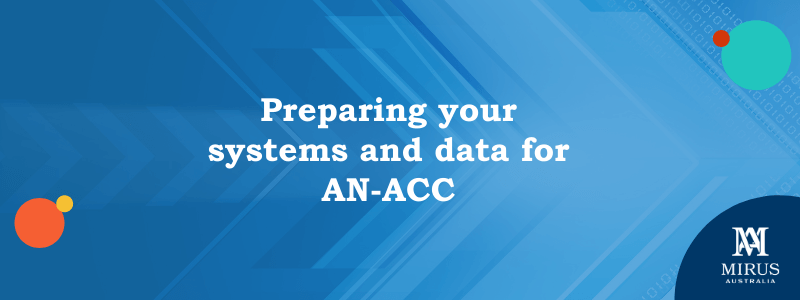How AN-ACC might change your systems and data
October 27, 2021 | AN-ACC

The systems we rely on and the data that populates our dashboards and reports are critical to operations in every part and every level of the business. Over the last 10 years, Aged Care providers have adapted to ACFI and for most operators, the information and systems have developed to support the business well. It is important that ACFI remains a priority with at least 12 months of ACFI funding remaining. It is also critical however, to consider how these systems and data requirements will need to change as the transition to AN-ACC occurs, because as we all know, changing systems and reporting is often not an easy thing to do.
We have developed the Mirus ACFI to AN-ACC Pathway (MAAP) to help providers to get started on the planning processes for the change. You answer 10 questions and we map your answers across five workstreams and three phases to provide your organisation with a holistic framework for how the changes might affect various parts of your business.
In our Finance blog, we explained the key impacts that AN-ACC will have on your funding and provided our tips for what to focus on now. In our People and Process blog, we discussed the training requirements and process changes that will affect your staff and operations. In this blog, we look at of the streams of Data and Systems, rounding out the five workstreams of our MAAP.
Workstream 4: Data
Data is often underrated in terms of its importance in the business and the value it creates. Considering it is what fills our systems, our reports and is the information we need to make every decision in the business, it could not be more important.
The transition from ACFI to AN-ACC will have significant impact on core systems and the data contained in them. Not all changes will be large, but they will be widespread and permeate through most of the information channels that exist in the business including:
- Clinical information
- Medicare data
- Admissions
- Funding information
- Billing information
- KPI reporting
- Management reporting
- Annual reporting
Further, the AN-ACC changes as part of the broader Aged Care Reform Agenda will also drive changes relating to the star rating and the 200 minute minimum care requirements.
Our three high level recommendations are simple:
- Keep ACFI data current. It will pay the bills until at least October 2022 and using ‘what you have now’ as a basis for what you might need is a good starting point.
- Identify gaps in data required. Not just changing data, because gaps could mean manual processes until systems can catch up.
- Move towards new reporting required to guide funding processes. The new funding model will still be the major source of revenue for Aged Care and any gaps in information may result in gaps in funding.
The best advice we can give you is to start the planning process early. At Mirus, we are not only staying across every piece of information as it becomes available, but we are also working with clients across Australia to gain valuable insight into the easiest and best ways to navigate the changes.
Workstream 5: Systems
(Manage clinical and ACFI information for the next 12 months, but also move to identify gaps in systems for new or different information required for AN-ACC)
The number of potential changes to systems can be a bit daunting. It seems the Aged Care industry is in a state of perpetual ‘upgrade’ of its technology. The new funding model will require more change to systems as added information and new processes need to be supported by existing systems.
The key systems most likely affected will be:
- Clinical Systems
- Finance and Billing systems
- Funding systems (Medicare data tools)
- Dashboards and BI tools
- Admission systems
Different providers will have different levels of impact depending on the amount of ACFI Funding data they currently store and share in their systems and how much AN-ACC data they will continue to use.
At the very least, there will be field name changes and training required to use systems differently. More likely, systems like the care systems, will require a sizeable rethink about how the new clinical information required to support the new funding model will be captured and reported. The external assessment model is one factor, but the change in types of assessments and types of information required will need to be reviewed with system vendors in the months leading up to the changeover.
The earlier these considerations are documented for your business, the more likely they can be considered as part of any system changes or upgrades and well in advance of the changes impacting clinical and other business operations.
We understand these challenges facing the industry as we provide a Medicare (ACFI) BI tool and benchmarking system – Mirus Metrics – to around 40% of the industry. We are well underway with our design and roadmap to make the necessary changes to the system in time for the new funding model. As requirements emerge, we will also be adding functionality to support Aged Care providers in the processing of AN-ACC external assessments. This may be required to fill any short term system or data gaps. Any client of Mirus is in safe hands when it comes to this important transition.
Try our diagnostic, sign up for our AN-ACC PMO and stay on our Partner and Metrics services.
Please contact us if you have any questions or need some support.


